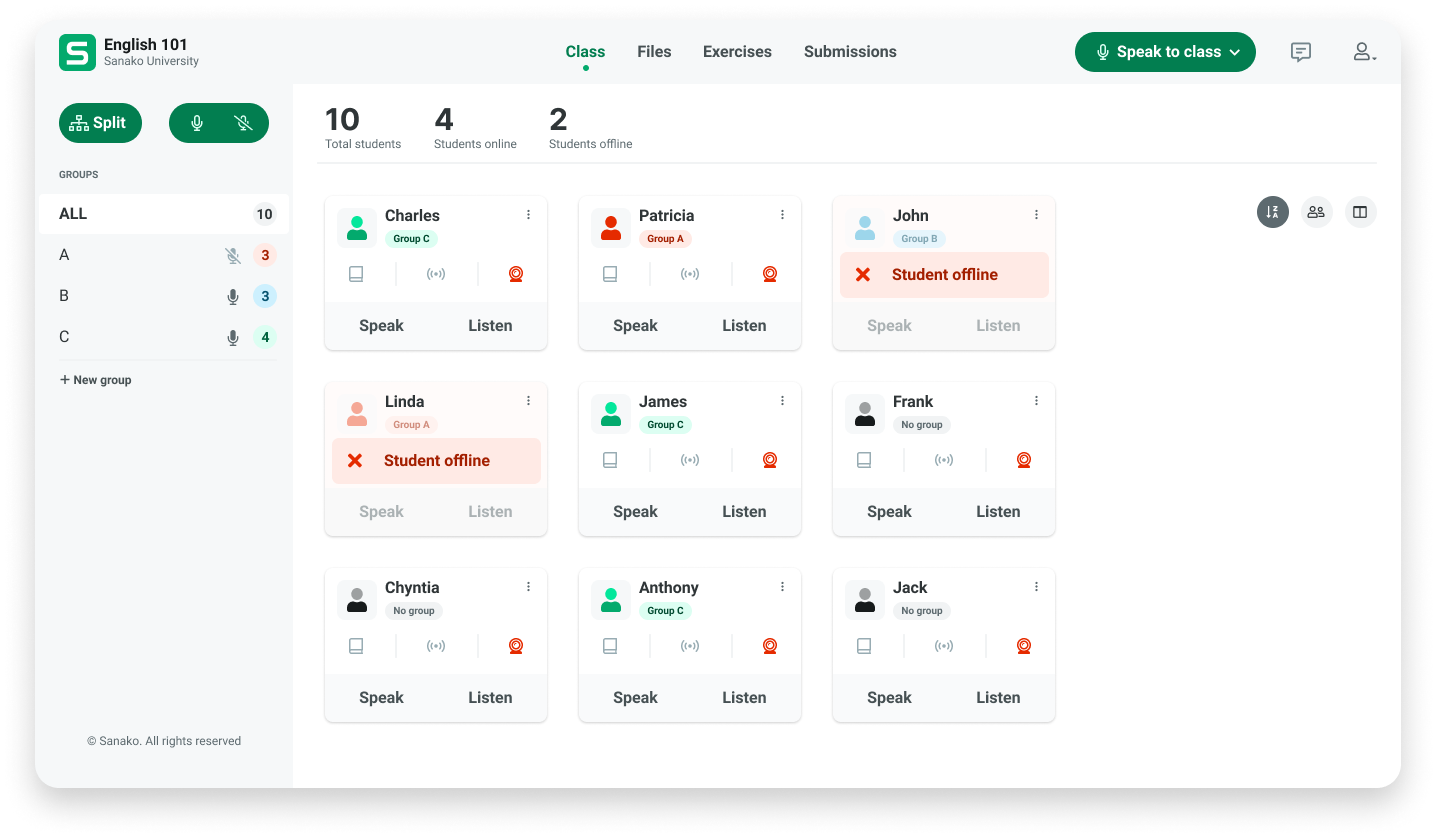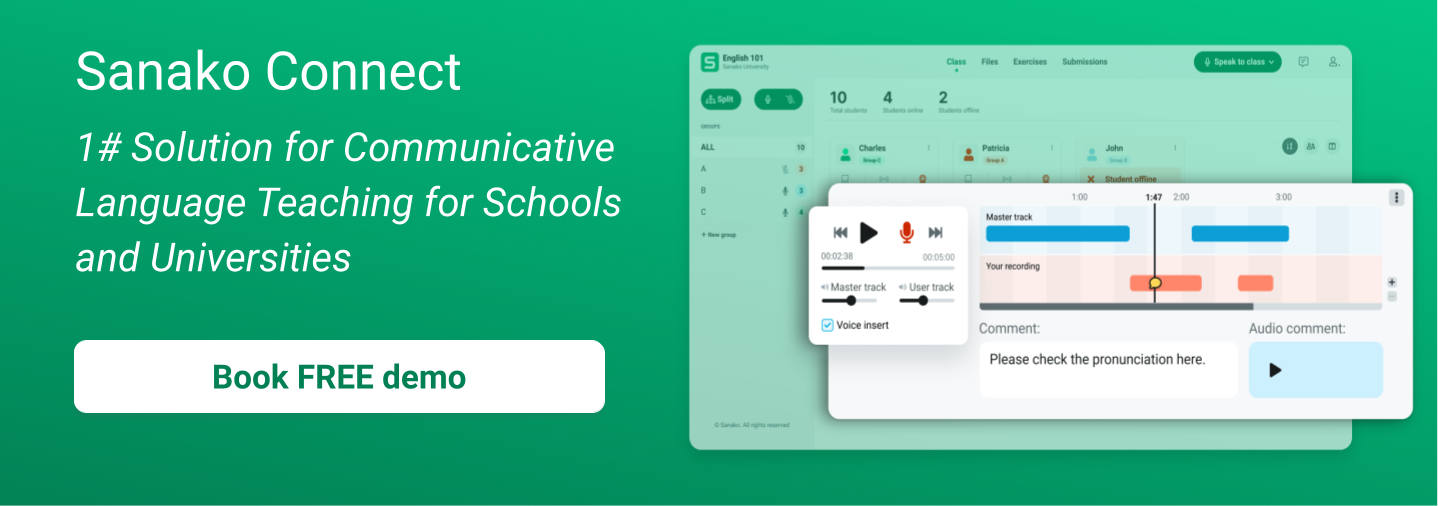In a blog post published in August 2020, we spoke to a number of language teachers from the USA about the impact that the Covid-driven shift to online learning had had on their language teaching. Two key, and linked, trends stood out from that conversation – firstly, that teachers felt opportunities to develop spontaneous speaking skills had “disappeared” from lesson delivery and that online synchronous speaking activities had become “monotonous and students quickly became bored.” Given the importance of developing spontaneous speaking skills, it’s important to understand how best to address these challenges.
The ability to develop strong spontaneous speaking skills is, after all, one of the main reasons why students learn a new language in the first place. Holding a conversation in your target language in a new country allows learners to communicate with different people, to express their thoughts clearly, and to join (at least for a while) a new community.
This blog post is therefore focused on the concept of spontaneous speaking skills and how they can be developed in today’s language learning environments. It also explores how language teaching software tools can be effectively used to support these skills and to engage students in their development.
What is spontaneous speaking in language education?
Well, the dictionary definition of spontaneous gives us a good starting place:
“Performed or occurring as a result of a sudden impulse or inclination and without premeditation or external stimulus.”
“Having an open, natural, and uninhibited manner.”
In foreign language teaching terms, spontaneous speaking should therefore be seen as unscripted speech, in which teachers do not know exactly what students will say, and/or vice versa. Indeed, the speaker (student or teacher) only has something to say as a result of having heard and understood what has been said to him/her. Pearson, the global education publisher, identifies it as “communicative language use” – this is therefore quite distinct from rehearsed or planned language use. In fact, as Hawkes 2012 notes, the best spontaneous speaking often involves an element of “struggle” as learners stretch their knowledge to the absolute limit in an effort to keep the conversation going.
Why is spontaneous speaking so important?
In a video on the subject, Pearson identifies three main reasons why teachers should prioritize spontaneous talk:
- Students equate the ability to speak in the target language with learning the language – it is the subject to them.
- Students believe that what they can produce in unrehearsed situations is what they really know.
- Theories of language learning prioritize such impromptu interactions as the primary site of learning.
Although the film is specifically targeted at MFL teachers in UK secondary schools, these three reasons are more widely applicable to all language learners and all language settings.
Interestingly, the Pearson video also identifies that spontaneous target language use, or more specifically the lack of it, has been highlighted as a major issue by Ofsted, the quality regulator for UK schools. In a 2008 report, Ofsted noted that: “Overall there is insufficient emphasis on helping students to use the language spontaneously for real situations. Consequently, too few students could speak creatively, or beyond the topic they were studying, by making up their own sentences in an unrehearsed situation.” Other research and anecdotal evidence suggest that this issue is prevalent across language teaching settings.
So, how can language educators ensure that opportunities for developing spontaneous conversational competence are prioritized and fully exploited in global language classrooms?
Creating spontaneous L2 speakers
It is worth beginning by noting that spontaneous language use cannot just be turned on at the flick of a switch. Educators should therefore seek to leverage the cumulative nature of language learning to promote a clear progression towards spontaneity. As part of this students can develop their skills and confidence from planned or structured speaking activities.
For example Dr. Gianfranco Conti identifies three stages in this process. Based on his arguments, there is firstly a highly scaffolded and controlled practice stage in which the students receive lots of prompts and support. Conti identifies that this stage requires intensive and extensive practice, with oral activities becoming progressively more challenging and seeking to elicit more ”varied and complex responses.”
This stage is then followed by what Conti describes as a “consolidation and expansion phase in which the language practiced and learnt during the first phase is reinforced through activities aiming at strengthening retention in preparation for the next phase, in which communicative practice will occur without scaffolding.” Classroom activities should offer opportunities for extensive speaking practice and students should be encouraged to be brave and to take risks.
Finally, Conti identifies an autonomous stage in which communication occurs without scaffolding. There’s an increasingly important role for the language educator here as they monitor performance, but without constantly correcting mistakes. (Our previous blog post on accuracy vs. fluency may also be of interest here.)
The other key part that teachers can play in building spontaneous speaking is to ensure that the target language should be used whenever and wherever possible. Given the choice, students will always lapse into using their native language if given the opportunity. Teachers should be consistent and rigorous in reinforcing the expectation to use the target language at all times.
It is perhaps easier to mandate these behaviours when students and teachers are together in a classroom and through building a community of learning. But with online learning taking an increasing role in language teaching, it’s vital that educators use online tools to better facilitate and encourage spontaneous, non-rehearsed conversations. In fact, Sanako Connect has been specifically developed to support educators to deliver on this objective.
How can Sanako Connect help in developing your students’ spontaneous speaking skills?
With customers in 114 countries and our language teaching products in use in over 50,000 classrooms globally, Sanako has significant experience in improving students’ learning outcomes, particularly their foreign language speaking skills.
Sanako Connect is perfectly suited for building spontaneous speaking skills. Educators can easily divide students into pairs or small groups for live conversation practice. This takes place online, so each group of students can talk simultaneously without distracting each other. Teachers can listen in or talk with different groups to assist as required. All individual conversations can be easily recorded and reviewed for feedback after the event, rather than interrupting live conversations.
Educators can also use Sanako Connect to create and share tasks addressing specific grammar or vocabulary. These include pronunciation tasks, model imitation, oral assessments, online tests, or fill-in-the-blanks exercises – all of which can be created by educators in minutes. This is important because speaking confidently without preparation requires a wide enough range of vocabulary for learners to express themselves across a range of different contexts.
The four elements of speaking skills
We have also created an instructional video for language educators, in which we’re going to talk about how to help students develop spontaneous speaking skills. In this video, we’ll share with you the 4 key pedagogical areas (Fluency & Coherence, Lexical resource, Grammatical range, Pronunciation) needed to practice with your students in order to get the best results from their speaking capabilities. You can watch the video below and remember to stay tuned until the end of the video, where we’ll share a free lesson plan from Sanako’s language teaching software to implement spontaneous speaking skills in your classroom!

If you’d like to find out more about how Sanako’s language teaching products could help improve your students’ spontaneous speaking skills, please contact us now to arrange your FREE demo!


